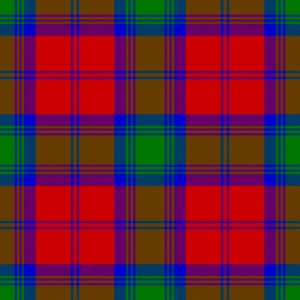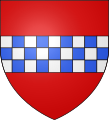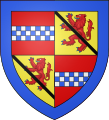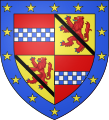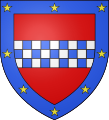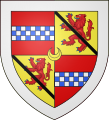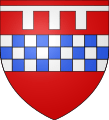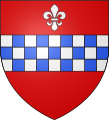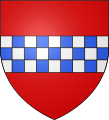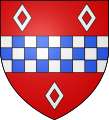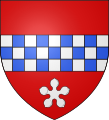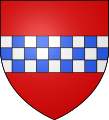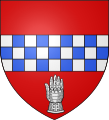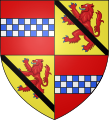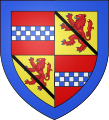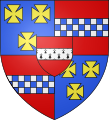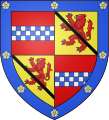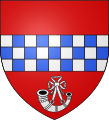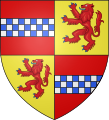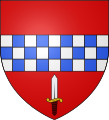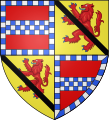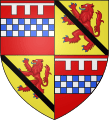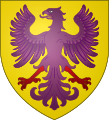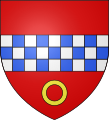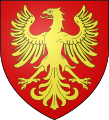Clan Lindsay facts for kids
Quick facts for kids Clan Lindsay |
|||
|---|---|---|---|

Crest: Issuing from an antique crest coronet Or, the head, neck and wings of a swan proper.
|
|||
| Motto | Endure Fort (Endure bravely) | ||
| Profile | |||
| Region | Lowlands | ||
| District | Angus | ||
| Plant badge | Lime Tree | ||
| Chief | |||
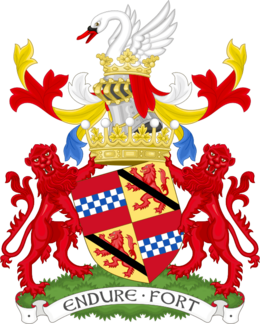 |
|||
| Anthony Lindsay | |||
| 30th Earl of Crawford and 13th Earl of Balcarres | |||
| Seat | Balcarres House | ||
| Historic seat | Crawford Castle Edzell Castle |
||
|
|||
|
|||
|
|||
|
|||
Clan Lindsay is a Scottish clan from the Scottish Lowlands. A clan is a group of families linked by a common ancestor or a shared surname. The Lindsays have a long and interesting history in Scotland.
Contents
History of Clan Lindsay
Where the Lindsays Came From
The Lindsay family became important in both England and Scotland around the late 1000s. Their name probably comes from a place called Lindsey in England. This name means "island of Lincoln" in Old English.
One of the earliest Lindsays was Sir Baldric de Lindsay. He owned many lands in Lindsey in 1086. His sons, Sir Walter and William de Lindsay, came to Scotland with David of Scotland, Earl of Huntingdon. David was trying to claim his throne.
William's son, also named William de Lindsay, was an important figure. He was part of the Scottish Parliament in 1164. He also held lands like Crawford and Luffness. The main leader of the Lindsays later gained the important title of Earl of Crawford.
Many Lindsays held high positions in Scotland. For example, Sir David Lindsay was a Lord and a High Justiciar (a top judge). Another cousin, Sir David Lindsay, was the Chamberlain of Scotland in 1256. This meant he managed the king's household and money.
Fighting for Scotland's Freedom
A grandson of David Lindsay, also named David, played a part in a very important event. In 1320, his seal was on a letter sent to the Pope. This letter declared that Scotland was an independent country. It is famously known as the Declaration of Arbroath.
David's second son, Sir James Lindsay, married Egidia. She was the daughter of Walter Stewart, 6th High Steward of Scotland. Egidia's mother was Marjory Bruce, who was the daughter of Robert the Bruce. This meant the Lindsays had a connection to the Scottish royal family!
Famous Lindsays and Big Battles
In 1390, Sir David Lindsay showed off his skills at a tournament in London Bridge. This event was watched by Richard II of England. Sir David won the tournament and earned the English king's respect.
Because of his achievements, David Lindsay was made the Earl of Crawford in 1398. He also held other important jobs. He was the Lord High Admiral of Scotland (in charge of the navy) in 1403. In 1406, he was sent as an ambassador to England.
The Lindsays were involved in many battles. They fought at the Battle of Arbroath in 1445. In 1452, Alexander Lindsay, 4th Earl of Crawford, joined a rebellion against James II of Scotland. He fought at the Battle of Brechin, but the king's army won. Alexander was punished for treason but was later forgiven.
The fifth Earl of Crawford became very popular with the king. He held many high positions, including Lord High Admiral and Master of the Royal Household. In 1488, King James III made him the Duke of Montrose. However, this title was taken away after the king died.
The sixth Earl of Crawford died bravely at the Battle of Flodden in 1513. He was fighting close to King James IV when he was killed.
The 1600s and Civil War
Ludovic Lindsay, 16th Earl of Crawford, was a soldier who learned his skills in other countries. He later fought for King Charles I during the English Civil War. He led a cavalry (horseback soldiers) group at the Battle of Marston Moor.
Ludovic was captured in 1645 while supporting James, Marquis of Montrose, at the Battle of Philiphaugh. After this, the title of Earl of Crawford went to his relative, John Lindsay, Earl of Lindsay.
Later, the Crawford title passed to the Earl of Balcarres in the 1800s. This branch of the family had been made Earls of Balcarres in 1650 for their help during the civil war.
The 1700s and Jacobite Risings
The first Earl of Balcarres was made the permanent governor of Edinburgh Castle. He also became the Secretary of State for Scotland.
His younger son, Colin Lindsay, 3rd Earl of Balcarres, was a strong supporter of the Jacobites. The Jacobites wanted to bring the old royal family back to the throne. Colin fought in the Jacobite rising of 1715. He was almost punished for treason, but his friend, the Duke of Marlborough, helped him escape.
In 1739, John Lindsay, 20th Earl of Crawford, became a leader in the 43rd Regiment of Foot. This regiment was also known as the "Black Watch." They supported the British Government during the Jacobite rising of 1745.
Gallery of arms
Clan Castles
- Balcarres House is where the current Chief of Clan Lindsay lives. It was built in 1595.
- Edzell Castle was an early castle of the Clan Lindsay Chiefs. They owned it from 1357 until 1715.
- Crawford Castle, near Crawford in South Lanarkshire, is where the title of Earl of Crawford came from. It was also known as Lindsay Tower.
- Luffness Castle, in East Lothian.
- Lamberton Castle, in the Scottish Borders.
- Wauchope Castle, in Dumfries and Galloway.
- Carsluith Castle.
- Spynie Palace.
- Lordscairnie Castle.
- Byres Castle, in East Lothian.
- Garleton Castle, in East Lothian.
- Barnweill Castle, in South Ayrshire.
- Craigie Castle, in South Ayrshire.
- Lindsane
See also
- Earl of Crawford
- Earl of Lindsay
- Endure Pursuivant
- Lord Spynie
- Scottish clan


